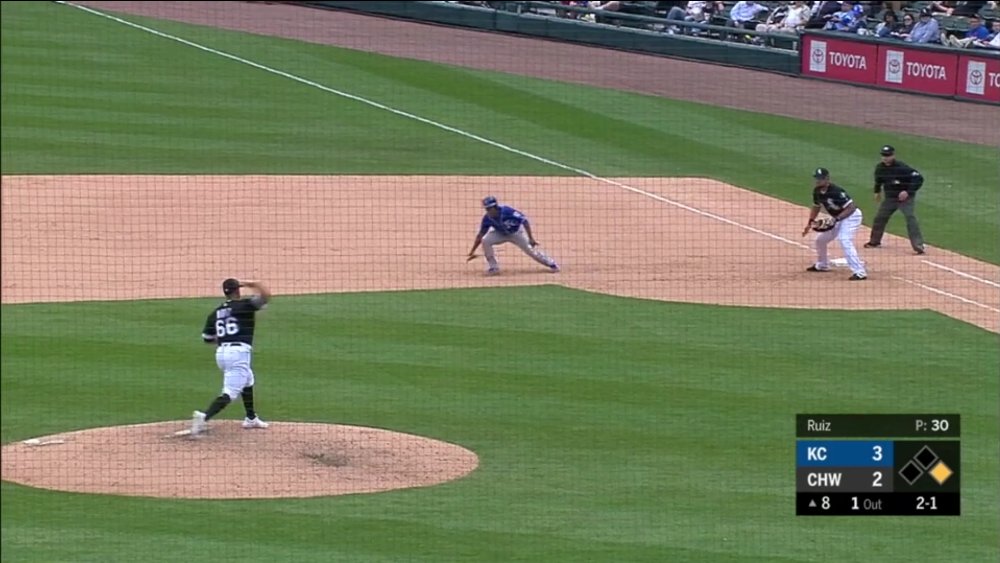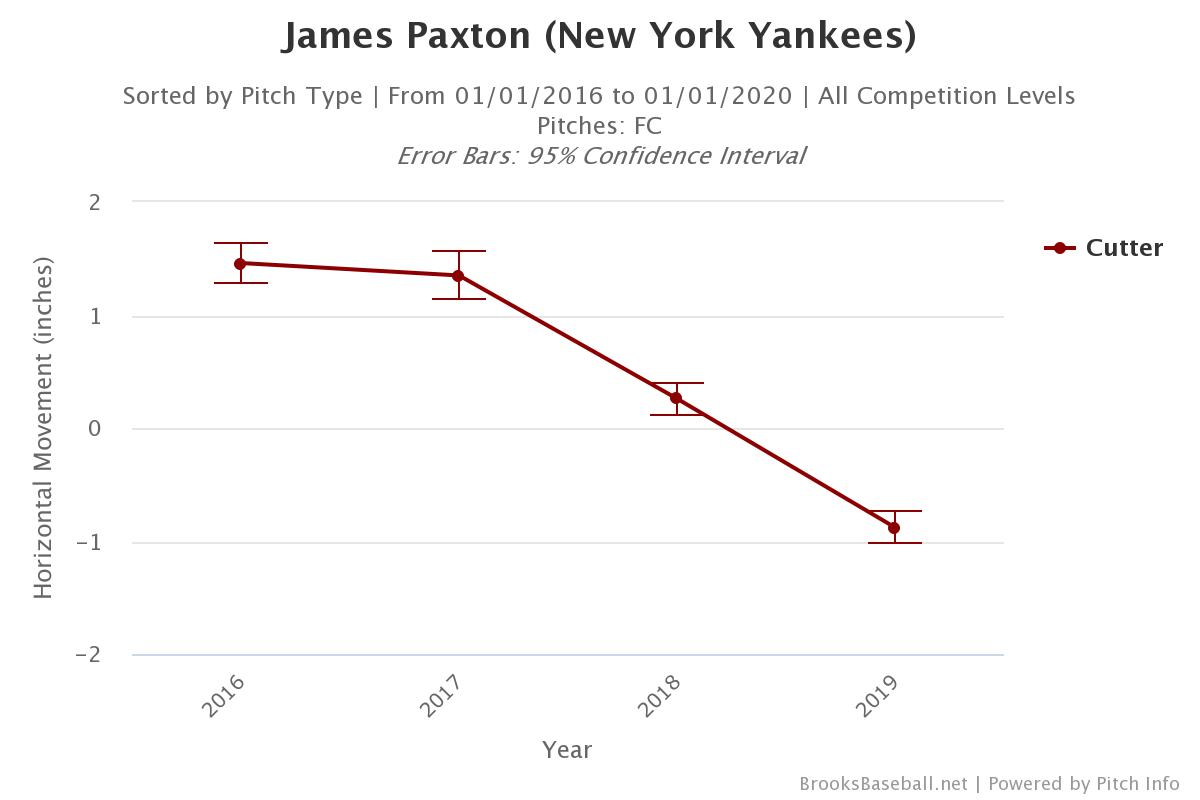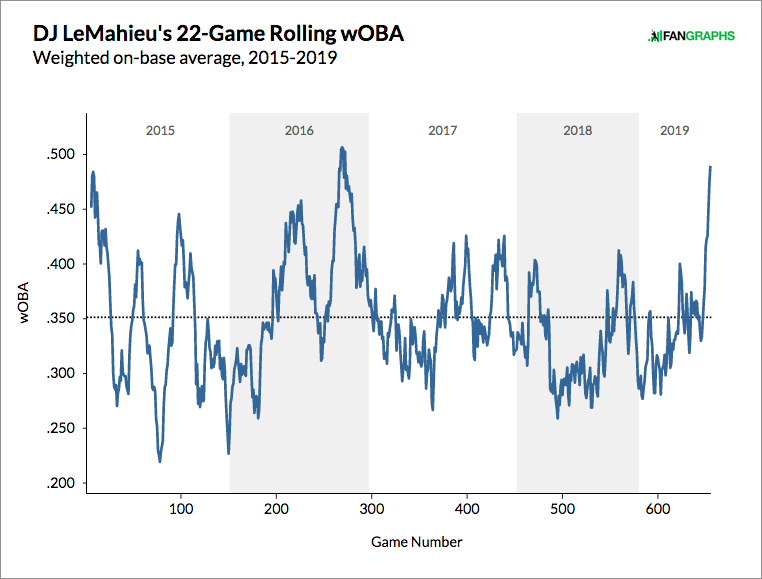The lingering suspense over whether the Yankees could break the major league record for consecutive games with a home run, which they had tied at 27 on Monday night, lasted until Tuesday night’s sixth pitch from Blue Jays starter Clayton Richard to Yankees leadoff hitter DJ LeMahieu. Boom!
In the brief interval that it took this scribe to tweet about that record — admittedly, while juggling a beer and a scorebook in section 422 of Yankee Stadium — Aaron Judge homered as well. In fact, solo home runs accounted for the Yankees’ entire output in their 4-3 victory, with Gleyber Torres and Edwin Encarnacion joining the party, too. The latter even broke out the parrot against his old team for just the second time since departing in the winter of 2016-17, that while a hawk literally watched his dinger from atop the right field foul pole.
Here’s the Yankees’ new perch after Wednesday, when Didi Gregorius’ second-inning home run off Toronto’s Trent Thornton further extended the streak (LeMahieu added another one in the Yankees’ come-from-behind win as well):
Most Consecutive Games With a Home Run
| Rk |
Team |
Start |
End |
Games |
| 1 |
Yankees |
5/26/2019 |
6/26/2019* |
29 |
| 2 |
Rangers |
8/11/2002 |
9/9/2002 |
27 |
| 3T |
Yankees |
6/1/1941 |
6/29/1941 |
25 |
| 3T |
Tigers |
5/25/1994 |
6/19/1994 |
25 |
| 3T |
Braves |
4/18/1998 |
5/13/1998 |
25 |
| 3T |
Padres |
6/28/2016 |
7/27/2016 |
25 |
| 3T |
Cardinals |
8/9/2016 |
9/6/2016 |
25 |
| 8 |
Dodgers |
6/18/1953 |
7/10/1953 |
24 |
| 9T |
Athletics |
7/2/1996 |
7/27/1996 |
23 |
| 9T |
Blue Jays |
5/31/2000 |
6/25/2000 |
23 |
| 9T |
Braves |
6/25/2006 |
7/24/2006 |
23 |
| 9T |
Mariners |
6/20/2013 |
7/19/2013 |
23 |
| 9T |
Dodgers |
8/21/2018 |
9/15/2018 |
23 |
SOURCE: Baseball-Reference
* = active
It doesn’t take the eyesight of a hawk to note that 11 of those 13 seasons are from the post-1992 expansion era, which has featured at least one home run per team per game — a level previously topped only in 1987 — in all but five seasons (1993, and every year from 2010-14 except for ’12). Four of those seasons, including three of the top seven, are from the 2016-19 period, which, as I noted on Monday in relation to Justin Verlander’s performance, is the first four-year stretch with at least 1.1 home runs per team per game. This year’s 1.36 per game is the all-time high, 0.1 ahead of the previous high set just two seasons ago, an increase of 8.7%. It’s 0.21 home runs per game (18.8%) higher than last year, and 0.5 homers per game (58.4% higher) than in 2014, the year of the post-1992 low:

If we factor in the ever-increasing strikeout rates, the rise is even sharper. This year’s rate of home runs per batted ball — that is, HR/(AB-SO+SF) — is 5.31%, 0.49 points (10.1%) higher than the previous high in 2017, 0.86 points (19.3%) higher than last year, and 2.08 points (64.2%) higher than 2014.
I’ll get back to that momentarily, but it’s worth noting that when the Yankees’ streak began in late May, only three of the seven players who contributed the most home runs to last year’s record-setting total of 267 were active, namely Aaron Hicks (who tied for second on the team with 27 homers), the sixth-ranked Torres (24), and seventh-ranked Gary Sanchez (18). Since then, the 1-2 punch of Giancarlo Stanton (38) and Judge (27) has returned from lengthy stints on the injured list, and Gregorius (27) has returned from off-season Tommy John surgery. Miguel Andujar (27) is out for the remainder of the season due to surgery to repair a torn labrum, but on June 16, the team traded for Encarnacion, who currently leads the league in homers (24, including three as a Yankee).
All of which is to say that it’s been a mix of A- and B-list players who have not only propelled this particular Yankee streak but have helped the team out-homer all but three other teams, namely the Twins (149), Mariners (145), and Brewers (138):
Home Runs by 2019 Yankees
Such are the Yankees’ power reserves that the acquisition of Encarnacion led to Frazier, who has hit a robust .283/.330/.513 (117 wRC+), being optioned to Triple-A Scranton/Wilkes-Barre, and remaining on the farm even as Stanton went back to the IL with a sprained posterior cruciate ligament in his right knee, the result of a baserunning mishap early in Tuesday night’s game. He’ll miss the upcoming London series against the Red Sox, and will be out for longer than the 10-day minimum. With or without Stanton, who has played just nine games this season, it’s not hard to imagine a more complete Yankees lineup overtaking the Twins in the home run department. But even if they don’t, the rather patchwork lineup has kept them on pace to eclipse last year’s total, which is a hint that the homer situation is simply getting silly.
League-wide, no individual is on pace to challenge Barry Bonds‘ single-season home run record of 73; Christian Yelich, who leads the majors with 29 homers, would finish with 62 if he were to keep hitting them at the same pace over the Brewers’ final 82 games as he has over his first 73 (he’s missed seven games with assorted aches and pains). However, with only five teams past the halfway point in their schedules heading into Thursday (the Mariners have played 84 games, the other four of those teams 82), a total of 56 players had reached the 15 homer plateau, meaning that they were on pace for 30 homers. The league-wide record for such players is 47, set in 2000. Four of the top five totals hail from the 1996-2001 stretch, with the fifth coming in 2017, when 41 players reached it. Similarly, 18 players have reached 20 homers, and are on pace for at least 40. The record for players with 40-homer seasons is 17, set in 1996, and we haven’t seen more than nine players do it in any Statcast-era season; there were nine in 2015, but just three last year. Yelich, Pete Alonso (27 homers through the Mets’ 81 games) and Cody Bellinger (26 homers through the Dodgers’ 82 games, including one on Wednesday) are on pace for at least 50 homers. Only in 1998 and 2001 did more than two players reach that plateau, with four apiece in both of those years, including the single-season record breakers, Mark McGwire and Barry Bonds.
Meanwhile, 14 of the majors’ 30 teams are on pace to set franchise records, with the top four surpassing last year’s Yankees:
Team Home Run Paces and Single-Season Records
| Rk |
Team |
G |
HR |
Pace |
Record |
Year |
Record |
| 1 |
Twins |
79 |
149 |
306 |
225 |
1963 |
Y |
| 2 |
Mariners |
84 |
145 |
280 |
264 |
1997 |
Y |
| 3 |
Brewers |
80 |
138 |
279 |
231 |
2007 |
Y |
| 4 |
Yankees |
80 |
134 |
271 |
267 |
2018 |
Y |
| 5 |
Astros |
81 |
131 |
262 |
249 |
2000 |
Y |
| 6 |
Dodgers |
82 |
131 |
259 |
235 |
2018 |
Y |
| 7 |
Braves |
81 |
126 |
252 |
235 |
2003 |
Y |
| 8 |
Cubs |
80 |
124 |
251 |
235 |
2004 |
Y |
| 9 |
Athletics |
82 |
126 |
249 |
243 |
1996 |
Y |
| 10 |
Padres |
80 |
121 |
245 |
189 |
2017 |
Y |
| 11 |
Diamondbacks |
82 |
120 |
237 |
220 |
2017 |
Y |
| 12 |
Angels |
81 |
117 |
234 |
236 |
2000 |
N |
| 13 |
Mets |
81 |
117 |
234 |
224 |
2017 |
Y |
| 14 |
Rangers |
80 |
113 |
229 |
260 |
2005 |
N |
| 15 |
Red Sox |
82 |
115 |
227 |
238 |
2003 |
N |
| 16 |
Reds |
78 |
108 |
224 |
222 |
2005 |
Y |
| 17 |
Nationals |
79 |
109 |
224 |
215 |
2017 |
Y |
| 18 |
Blue Jays |
81 |
107 |
214 |
257 |
2010 |
N |
| 19 |
Rockies |
80 |
104 |
211 |
239 |
1997 |
N |
| 20 |
Indians |
80 |
104 |
211 |
221 |
2000 |
N |
| 21 |
Rays |
80 |
101 |
205 |
228 |
2017 |
N |
| 22 |
Phillies |
80 |
100 |
203 |
224 |
2009 |
N |
| 23 |
Cardinals |
79 |
95 |
195 |
235 |
2000 |
N |
| 24 |
Orioles |
80 |
94 |
190 |
257 |
1996 |
N |
| 25 |
White Sox |
78 |
90 |
187 |
242 |
2004 |
N |
| 26 |
Pirates |
78 |
79 |
164 |
171 |
1999 |
N |
| 27 |
Royals |
81 |
81 |
162 |
193 |
2017 |
N |
| 28 |
Giants |
79 |
72 |
148 |
235 |
2001 |
N |
| 29 |
Tigers |
76 |
66 |
141 |
225 |
1987 |
N |
| 30 |
Marlins |
78 |
60 |
125 |
208 |
2008 |
N |
SOURCE: http://www.baseball-almanac.com/recbooks/rb_hr7.shtml
All but three of the 30 teams are averaging at least one homer per game. Twenty-two teams are on pace for 200 homers, one fewer than in all of baseball prior to the 1994 players’ strike. Only in 2017, when 17 teams reached that plateau, have there even been as many as a dozen teams to do so. Eight teams are on pace for 250 homers, a level reached by just six teams ever prior to this year. The mind reels at these numbers.
While one can point to the general trend of batters making greater efforts to elevate the ball — whether to hit it over shifted infielders or not — it’s more accurate to call that an adaptation to the new reality. The scientific evidence again points to the ball itself as being the driving factor. Earlier this week at The Athletic, Dr. Meredith Wills published a follow-up to last year’s breakthrough article, which itself was a follow-up to MLB’s Home Run Committee report. That committee, led by Dr. Alan Nathan, professor emeritus of physics at the University of Illinois, had found that the recent home run spike was caused by a decrease in the ball’s aerodynamic drag, but found no physical difference in the balls that would explain the change.
Conducting her own measurements using digital calipers and disassembled baseballs, Wills concluded that post-2015 balls’ laces, which were an average of nine percent thicker than balls from the 2010-14 period, were producing less bulging at the seams, yielding a more spherically symmetric ball with less aerodynamic drag — thus allowing them to fly further.
For her latest study, Wills examined 39 balls from this season, which she found differed from the 2015-18 balls and even earlier ones. Most notably, she found “demonstrably lower” seams, only 54.6 percent ± 15.0 percent as high as those on balls from previous seasons. By measuring the coefficient of static friction, she also found that the leather on this year’s balls is relatively smoother, concluding, “the static friction for the 2019 balls is 27.6 percent lower, a statistically significant result demonstrating the leather covers are genuinely smoother.” She measured the bulging of the seams and found, “Not only were the 2019 balls virtually round, what bulging they did show was slightly negative, suggesting the seams might be slightly ‘nestled’ into the leather.” The significantly rounder balls, which have thinner laces than last year’s (more in line with 2000-14 samples) produce even less drag than before, and thus even more carry. Wills noted that both the seam and smoothness issues jibe with anecdotal reports from pitchers about difficulties in gripping this year’s balls, as voiced by players such as Sean Doolittle, Jon Lester, and Noah Syndergaard.
As for commissioner Rob Manfred’s recent suggestion that a better-centered pill (the core of the ball) is a factor in creating less drag, Wills was largely dismissive, writing, “[T]his is the most difficult result to produce without significant manufacturing changes, since existing techniques make it hard to keep the pill from being centered to begin with… Therefore, it seems unlikely that pill-centering would explain a sudden change in drag; at the very least, we would be remiss not to also examine other possible sources.”
All of Wills’ articles on the topic, which are behind a paywall, are worth reading, but it should suffice to say that there’s ample scientific evidence that the ball is carrying this. And how. Check out these numbers, which combine Statcast’s average distance measurements with those from our stat pages:
Fly Balls in the Statcast Era
| Year |
Avg FB Dist |
FB% |
HR/FB |
HR/Gm |
HR/CON |
| 2015 |
315 |
33.8% |
11.4% |
1.01 |
3.80% |
| 2016 |
318 |
34.6% |
12.8% |
1.16 |
4.39% |
| 2017 |
320 |
35.5% |
13.7% |
1.26 |
4.82% |
| 2018 |
319 |
35.4% |
12.7% |
1.15 |
4.45% |
| 2019 |
323 |
35.7% |
15.0% |
1.36 |
5.31% |
SOURCE: Baseball Savant
Fly balls are carrying an average of four feet further than last year, and eight feet further than in 2015. Add to that a general increase in fly ball rates and you have a recipe for significantly more homers. Perhaps too many homers. Combine that trend with the aforementioned strikeout trend and lower batting averages — though this year’s .251 is three points higher than last year, it’s in a virtual tie with 2014 for the second-lowest mark of the DH era, which began in 1973 — and the result is a greater percentage of runs being scored via homer than ever before. Here’s an historic look at what Joe Sheehan christened “the Guillen Number” a decade ago at Baseball Prospectus:

For a period of over two decades, from 1994-2014 — two decades that saw record home run rates, PED scandals, expansion, new ballparks galore — the rate of runs scored via homers was remarkably stable around 35%, never deviating more than two points in either direction. It hit 37.3% in 2015, and has climbed at a rate of about two points per year since, to heights previously unseen, and now, both statistically and aesthetically, the situation sticks out like a sore thumb. Ken Rosenthal called it “Bludgeon Ball” earlier this month, and I think the description fits. This is brute force baseball, and while it doesn’t lack for a certain amount of excitement, it’s very lacking in subtlety. When nearly half the league is on pace to set home run records, and the vast majority of teams are set to exceed totals that were once very rare, we’ve gone too far.
It’s time for MLB and Rawlings (which the league bought last year) to fix this. Wills noted that while Manfred has maintained that Rawlings hasn’t changed its manufacturing process or materials “in any meaningful way,” this may be an issue of semantics:
The Home Run Committee found that Rawlings regularly implements production improvements, including changes to the yarn (February 2014), the pill (March 2014, May 2015), the leather (June 2014, February 2017, August 2017) and the drying process (March 2016, February 2018). The Committee described these changes as “largely technical in nature and very unlikely to be in any way related to the (2017) home run increase.” That being the case, things like enhancing leather smoothness or drying baseballs more efficiently might not be considered “meaningful” to manufacturing.
While this may have been a reasonable attitude in the past, such enhancements now appear to have compounded, producing a more aerodynamic ball.
Wills recommended another committee report with the goal of using the information to tighten specifications, improve quality control and “determine further production improvements.” To these eyes — and I know I’m not alone — such improvement would include the restoration of some normalcy. When a player’s 40-homer season, or a team’s mountain of 200 homers, is no longer worthy of celebration, is as common as a garden weed, we’ve lost something. It’s worth searching for how to get that special something back.






